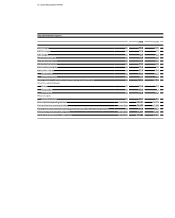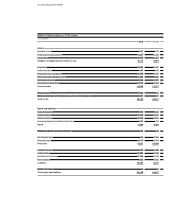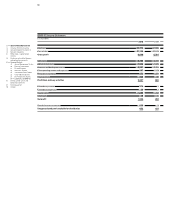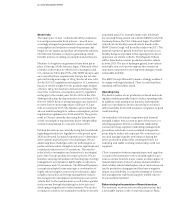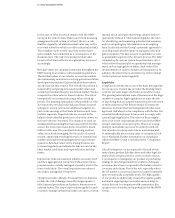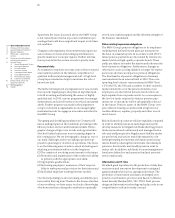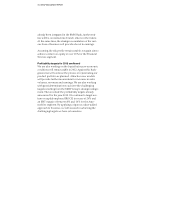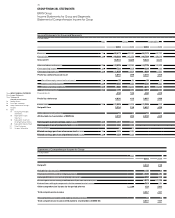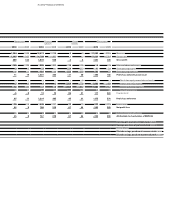BMW 2010 Annual Report Download - page 67
Download and view the complete annual report
Please find page 67 of the 2010 BMW annual report below. You can navigate through the pages in the report by either clicking on the pages listed below, or by using the keyword search tool below to find specific information within the annual report.65 GROUP MANAGEMENT REPORT
Sector risks
The future price of fuel – influenced both by market fac-
tors and governmental fiscal policies – as well as in-
creasingly stringent requirements to reduce vehicle fuel
consumption and emissions remain the primary chal-
lenges for our engine and product development activities.
Our Efficient Dynamics concept is generating visible
benefits in terms of cutting consumption and emissions.
Medium- to long-term requirements have been put in
place in Europe, North America, Japan, China and other
countries with respect to vehicle fuel consumption and
CO2 emissions. More than 90% of the BMW Group’s sales
are covered by these requirements. Europe has set a tar-
get of achieving an average of 130g / km for all new vehi-
cles by 2015. EU regulations set targets for CO2 emissions
based on vehicle weight. For our product range, a target
of below 140g / km has been derived on the basis of the
new rules. A uniform consumption and CO2 regulation
will apply for the model years 2012 to 2016 in the USA.
Starting with a step-by-step reduction in model year 2012,
the new vehicle fleets of all manufacturers are expected
to come down to an average value of 250g of CO2 per
mile in model year 2016. The Japanese government has
also set ambitious targets to reduce consumption, includ-
ing statutory regulations for 2010 and 2015. The govern-
ment in China is currently discussing the introduction
offuel consumption requirements (more stringent than
current ones) planned to come into force in 2012.
Political discussions are currently being held worldwide
regarding potential new legislation for the period up to
2020 and beyond. Increased expectations for alternative
drive systems and fuels pose new challenges. We are
addressing these challenges with our technological ex-
pertise and innovative strength to achieve significant and
consistent reductions in CO
2
emissions. The need to
reduce both consumption and emissions is an integral
part of the Group’s product innovation process. We are
therefore carrying out studies into the interplay of energy
management, aerodynamics, lightweight construction,
performance and CO2 emissions. The Efficient Dynamics
concept was adopted some years ago: a combination of
highly efficient engines, improved aerodynamics, light-
weight construction and energy management reduces
the average fuel consumption and emissions across the
vehicle fleet. In the medium term we will achieve greater
fuel economy through electrifying the drive train and
developing comprehensive hybrid systems. We are also
working on solutions for sustainable mobility in densely
populated areas. For example, large-scale field trials
arecurrently being carried out with the MINI E in the UK,
Germany, France, the USA, China and Japan. The BMW
ActiveE, an electrically powered vehicle based on the
BMW1 Series Coupé, will be on the roads from 2011. The
practical experience gained from these two trials is con-
tinually being incorporated in the ongoing series devel-
opment of our electric vehicles. The Megacity Vehicle
will be launched as a series production electric vehicle
asfrom 2013. The use of hydrogen gained from various
renewable sources to power engines also remains an
important component in our long-term strategy towards
sustainable mobility.
The BMW Group’s Efficient Dynamics strategy enables it
to comply with legal standards. There is a risk that these
standards will be further raised.
Operating risks
The flexible nature of our production network and work-
ing time models generally helps to reduce operating risks.
In addition, risks arising from business interruptions
andloss of production are also insured up to economi-
cally reasonable levels with insurance companies of good
credit standing.
An evaluation of technical competence and financial
strength is taken into account as part of the process of
selecting suppliers. Before a contractual relationship
comes into being, supplier relationship management
procedures, which also cover social and ecological as-
pects, help to reduce risk exposure. We continue to
as-
sess and manage supplier performance during the
series production phase, thus creating the basis for
enduring and stable working relationships with our
suppliers.
Close cooperation between manufacturers and suppliers
is usual in the automotive sector, and although this pro-
vides economic benefits, it also creates a certain degree of
mutual dependence. Delivery delays and cancellations
due to strikes, natural catastrophes, fire or insolvencies
can
lead to production stoppages and thus have a negative
impact on profitability. A consistent strategy of interven-
tion management enabled all supplier-related crises to
be successfully mastered.
Risks relating to the provision of financial services
The economic recovery seen over the past year has had
afavourable impact on the overall risk situation. Risks




